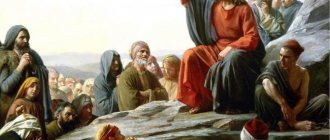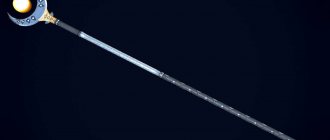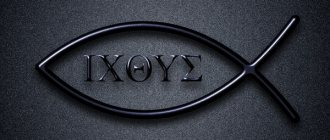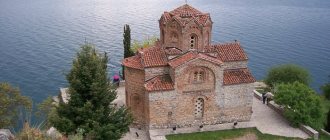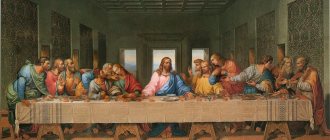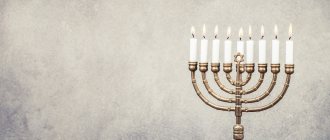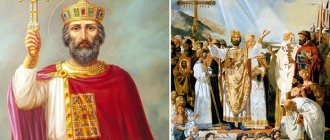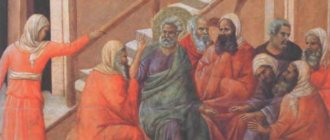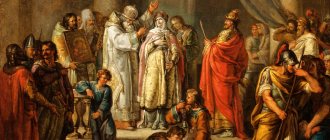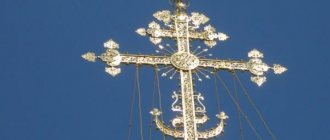As you know, the first three centuries of Christian history were marked by periodically recurring persecutions. In such conditions, it was necessary to develop a whole system of secret signs with the help of which it was possible to identify brothers in faith. In addition, the theology of the image also developed. Christians were looking for symbols with the help of which they could allegorically convey to the catechumens the truths of faith contained in the Gospel, and decorate the premises for worship, so that the very setting would remind them of God and set them up for prayer.
This is how a number of original early Christian symbols appeared, about which there will be a further short story.
Anchor
The Church is, first of all, the solid foundation of human life. Thanks to him, a person gains the ability to distinguish good from evil, understands what is good and what is bad. And what could be firmer and more reliable than an anchor that holds a huge ship of life in place in the stormy sea of human passions? Also - a symbol of hope and the future resurrection from the dead. By the way, on the domes of many ancient temples it is precisely the cross in the form of an ancient Christian anchor that is depicted, and not any “cross defeating the Muslim crescent.”
Andrey Szegeda: Christian cross - what is it like?
In today's material we will try to talk about what types of crosses there are. In particular, you will find out: whether there are “Orthodox” and “Catholic” crosses, whether a Christian can treat a cross with contempt, whether crosses are in the shape of an anchor, why we also venerate a cross in the shape of the letter “X” and much more interesting things.
Cross in the church
First, let's remember why the cross is important to us. The veneration of the cross of the Lord is associated with the atoning sacrifice of the God-man Jesus Christ. By honoring the cross, an Orthodox Christian pays veneration to God Himself, who became incarnate and suffered on this ancient Roman instrument of execution for our sins. Without the cross and death there would be no redemption, resurrection and ascension, there would be no establishment of the Church in the world and no opportunity to follow the path of salvation for every person.
Since the cross is so revered by believers, they try to see it as often as possible in their lives. Most often, a cross can be seen in a temple: on its domes, on sacred utensils and vestments of clergy, on the chests of priests in the form of special pectoral crosses, in the architecture of the temple, which is often built in the shape of a cross.
Cross behind the church fence
In addition, it is common for a believer to expand his spiritual space to the entire life around him. A Christian sanctifies all its elements, first of all, with the sign of the cross.
Therefore, in cemeteries there are crosses over the graves, as a reminder of the future resurrection, on the roads there are worship crosses, sanctifying the path, on the bodies of Christians themselves there are crosses on the body, reminding a person of his high calling to follow the path of the Lord.
Also, the shape of a cross among Christians can often be seen in home iconostases, on rings and other household items.
Pectoral cross
The pectoral cross is a special story. It can be made from a wide variety of materials and have all kinds of sizes and decorations, retaining only its shape.
In Russia, they are accustomed to seeing a pectoral cross in the form of a separate object hanging on a chain or rope on the chest of a believer, but in other cultures there were other traditions. The cross could not be made of anything at all, but applied to the body in the form of a tattoo, so that a Christian could not accidentally lose it and so that it could not be taken away. This is exactly how the Celtic Christians wore the pectoral cross.
It is also interesting that sometimes the Savior is not depicted on the cross, but an icon of the Mother of God or one of the saints is placed on the field of the cross, or even the cross is turned into something like a miniature iconostasis.
About the “Orthodox” and “Catholic” crosses and contempt for the latter
In some modern popular science articles, one can find the statement that an eight-pointed cross with a short upper and oblique short lower additional crossbars is considered “Orthodox”, and a four-pointed cross elongated at the bottom is “Catholic” and the Orthodox supposedly belong or in the past belonged to it with contempt.
This is a statement that does not stand up to criticism. As you know, the Lord was crucified on a four-pointed cross, which, for the above reasons, was revered by the Church as a shrine long before the Catholics fell away from Christian unity, which occurred in the 11th century. How could Christians despise the symbol of their salvation?
In addition, at all times, four-pointed crosses were widely used in churches, and even now on the chests of Orthodox clergy one can find several possible forms of the cross - eight-pointed, four-pointed and figured with decorations. Would they really wear some kind of “non-Orthodox cross”? Of course not.
Eight-pointed cross
The eight-pointed cross is most often used in the Russian and Serbian Orthodox Churches. This form recalls some additional details of the Savior’s death.
An additional short upper crossbar denotes the titlo - the tablet on which Pilate inscribed the guilt of Christ: “Jesus of Nazareth - King of the Jews.” In some images of the crucifixion, the words are abbreviated to form "INCI" - in Russian or "INRI" - in Latin.
The short oblique lower crossbar, usually depicted with the right edge raised up and the left edge down (relative to the image of the crucified Lord), denotes the so-called “standard of righteousness” and reminds us of the two thieves crucified on the sides of Christ and their posthumous fate. The right one repented before death and inherited the Kingdom of Heaven, while the left one blasphemed the Savior and ended up in hell.
St. Andrew's cross
Christians venerate not only a straight cross, but also an oblique four-pointed cross, depicted in the form of the letter “X”. Tradition tells that it was on a cross of this shape that one of the twelve disciples of the Savior, the Apostle Andrew the First-Called, was crucified.
The “St. Andrew’s cross” is especially popular in Russia and the Black Sea countries, since it was around the Black Sea that the missionary path of the Apostle Andrew passed. In Russia, the St. Andrew's cross is depicted on the flag of the navy. In addition, the St. Andrew's cross is especially revered by the Scots, who also depicted it on their national flag and believe that the Apostle Andrew preached in their country.
T-cross
This cross was most common in Egypt and other provinces of the Roman Empire in North Africa. Crosses with a horizontal beam superimposed on a vertical post, or with a crossbar nailed just below the top edge of the post, were used to crucify criminals in these places.
Also, the “T-shaped cross” is called the “cross of St. Anthony” in honor of the Venerable Anthony the Great, who lived in the 4th century, one of the founders of monasticism in Egypt, who traveled with a cross of this shape.
Archbishop's and Papal crosses
In the Catholic Church, in addition to the traditional four-pointed cross, crosses with second and third crossbars above the main one are used, reflecting the hierarchical position of the bearer.
A cross with two bars signifies the rank of cardinal or archbishop. This cross is sometimes also called the “patriarchal” or “Lorraine”. The cross with three bars corresponds to papal dignity and emphasizes the high position of the Roman Pontiff in the Catholic Church.
Lalibela Cross
In Ethiopia, church symbolism uses a four-pointed cross surrounded by a complex pattern, which is called the “Lalibela cross” in honor of the holy Negus (king) of Ethiopia Gebre Meskel Lalibela, who ruled in the 11th century. Negus Lalibela was known for his deep and sincere faith, assistance to the Church and generous giving of alms.
Anchor cross
On the domes of some churches in Russia you can find a cross that stands on a crescent-shaped base. Some mistakenly explain such symbolism as wars in which Russia defeated the Ottoman Empire. Allegedly, “the Christian cross tramples the Muslim crescent.”
This shape is actually called the Anchor Cross. The fact is that already in the very first centuries of the existence of Christianity, when Islam had not even arisen, the Church was called the “ship of salvation”, which delivers a person to the safe haven of the Heavenly Kingdom. The cross was depicted as a reliable anchor on which this ship could wait out the storm of human passions. The image of a cross in the form of an anchor can be found in the ancient Roman catacombs where the first Christians hid.
Celtic cross
Before converting to Christianity, the Celts worshiped various elements, including the eternal luminary - the sun. According to legend, when Saint Patrick enlightened Ireland, he combined the symbol of the cross with the earlier pagan symbol of the sun to show the eternity and importance for each convert of the Savior's sacrifice.
Chrism - a hint of the cross
During the first three centuries, the cross, and especially the Crucifixion, were not depicted openly. The rulers of the Roman Empire began a hunt for Christians and they had to identify each other using not too obvious secret signs.
One of the hidden symbols of Christianity closest to the cross in meaning was “chrism” - a monogram of the name of the Savior, usually made up of the first two letters of the word “Christ”, “X” and “R”.
Sometimes symbols of eternity were added to the “chrism” - the letters “alpha” and “omega” or, as an option, it was made in the form of an St. Andrew’s cross crossed out by a transverse line, that is, in the form of the letters “I” and “X” and could be read as "Jesus Christ".
There are many other varieties of the Christian cross, which are widely used, for example, in the international award system or in heraldry - on the coats of arms and flags of cities and countries.
Andrey Szegeda
Dear friends! I opened my own blog! If you are interested in reading my articles, please support me by subscribing and reposting!
You can applaud the author (at least 10 times)110
Phoenix
The image of the Resurrection, associated with the ancient legend of the eternal bird. The Phoenix lived for several centuries and, when the time came for him to die, he flew to Egypt and burned there. All that was left of the bird was a pile of nutritious ashes in which, after some time, a new life was born. Soon a new, rejuvenated Phoenix rose from it and flew away in search of adventure.
In heraldry
The anchor cross is also used in coats of arms and flags, in this context they are designated by the heraldic terms "ankri" or "ankr".[10] Examples of this can be found in the hook anchor representing Vinnitsa, Ukraine; a three-leaf cross with an anchor on the coat of arms of Pyhäranta, Finland; a patriarchal cross with an anchor on the coat of arms of the municipality of Barkakra, Sweden, and Wollmatingen [], Germany; coat of arms of Leon, Spain and Tallinn, Estonia; and personal shield Claude Veidt, Archbishop of the Roman Catholic Archdiocese of Ex.
Recommendations
- ^ a b
Klepping, Laura (2012).
Customs, Practices, and Symbols of the Protestant Religion
. GREEN Verlag. clause 5. ISBN 978-3-656-13453-4. - Hebrews 6:19
- Granger, John D. (1990). Seleucus Nicator: Building a Hellenistic Kingdom
. Rutledge. clause 2. ISBN 978-0-415-04701-2. - "What is the origin of the anchor as a Christian symbol and why don't we use it anymore?" CHRISTIAN HISTORY
. - Maurice Hassett (1913). "Anchor (as a symbol)." In Herbermann, Charles (ed.). Catholic Encyclopedia
. New York: Robert Appleton Company. - "What does the anchor cross mean?" United Methodist Church
. July 19, 2022. - "Une Croix du pont du Mort, on the website of the Camargue Museum" (In French).
- "La Croix Camarguez". www.chevalcamargue.fr
(In French). Retrieved July 20, 2022. - Stracke, Richard (20 October 2015). "Saint Clement: Iconography". Christian iconography
. - Pimbley, Arthur Francis (1908). Pimbley Dictionary of Heraldry: Complete with Illustrated Appendix
. clause 3.
Gallery
- Anchor cross options
- Admiralty type anchor
- Drainless anchor cross
- Anchor cross with rope
- Anchor with wheel (wheel cross)
- Camargue cross
- Cross
- Cross of St. Clement
- Anchor cross used in heraldry
- Anchor with hook representing Vinnitsa
- Red anchor cross
- Cross bottony at anchor on the coat of arms of Pyhäranta, Finland
- Patriarchal cross with anchor on the coat of arms of the Barkakrin Municipality (Skåne County, Sweden)
- Anchor of the Patriarchal Cross on the coat of arms of Wollmatingen [], Germany
- Coat of arms of the Czech city Odolena Voda
- Leon, Spain
- Tallinn, Estonia
- Szeliga
- Claude Veidt Retired Archbishop of Aix-en-Provence
